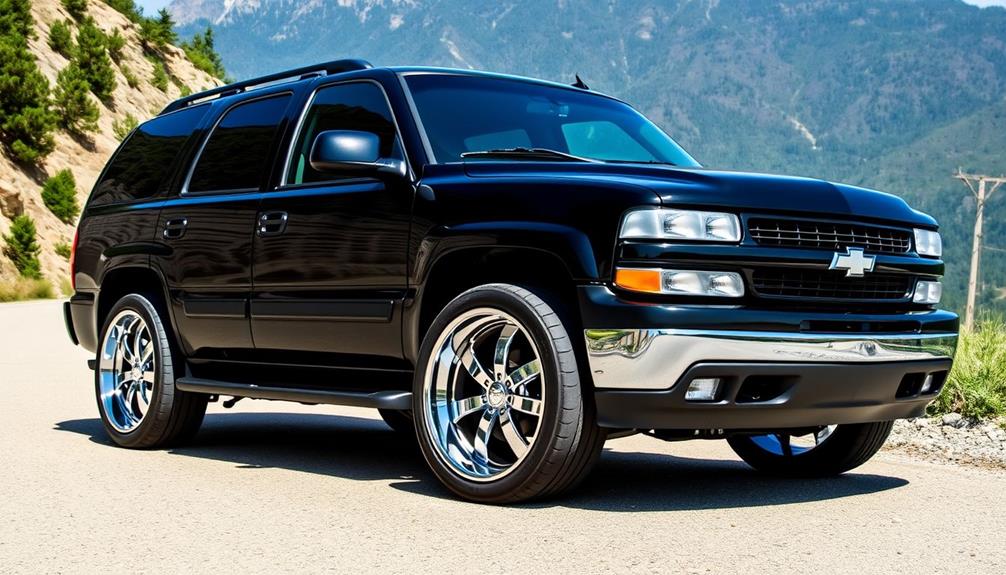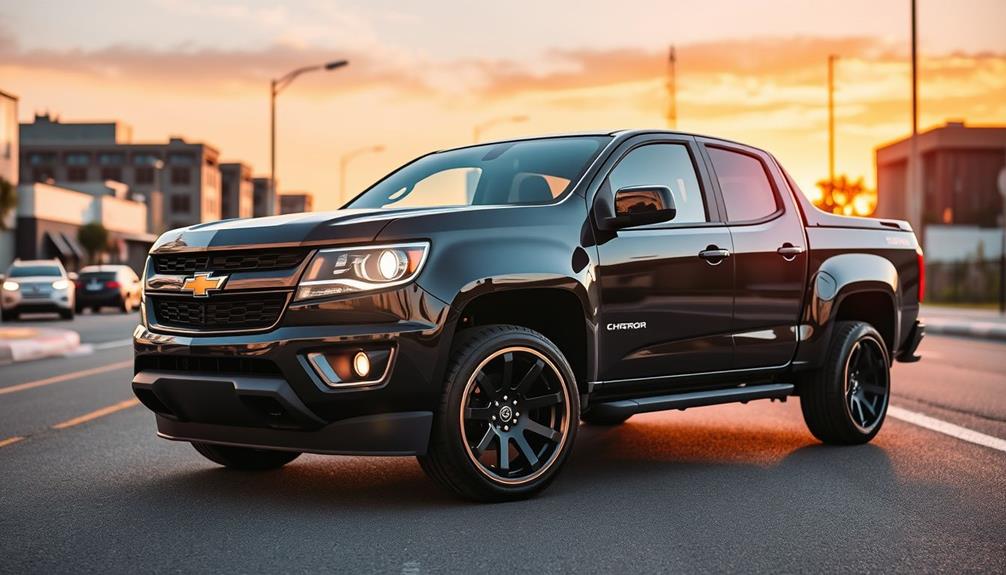Tuning your 2001 Chevrolet Tahoe can seriously enhance its power and performance. You've got several options, like AutoCal and traditional tuning, which can add 15-30 horsepower and improve torque. Consider bolt-on upgrades like a K&N cold air intake or long tube headers for better airflow and increased efficiency. If you're looking for more punch, a supercharger can give you over 50 additional horsepower. These adjustments not only enhance driving experience but can also improve fuel economy. Want to find out the best combination of upgrades and tuning for your Tahoe? There's a lot more to explore!
Key Takeaways
- Tuning options for the 2001 Chevrolet Tahoe include AutoCal, Scan Cable, and Traditional, catering to various performance needs and budgets.
- Performance gains from tuning typically range from 15-30 horsepower and 15-25 ft-lbs of torque, enhancing overall driving experience.
- Bolt-on upgrades, such as cold air intakes and performance programmers, can significantly improve horsepower and fuel efficiency without extensive modifications.
- Supercharger installations can yield substantial horsepower increases, often exceeding 50 hp, while improving acceleration and quarter-mile times.
- Custom tuning options utilize real-time data for precise adjustments, optimizing power delivery and vehicle performance tailored to individual specifications.
Tuning Services Overview
When considering tuning your 2001 Chevrolet Tahoe, you'll find three main options: AutoCal, Scan Cable, and Traditional. Each of these tuning services offers unique benefits and price points, ranging from $325 to $775, depending on what you choose.
With tuning, you can expect common performance gains of 15-30 horsepower and an increase of 15-25 ft-lbs of torque. These improvements not only enhance your Tahoe's power but also optimize features like shift patterns and towing capabilities. You'll even notice better fuel economy, making your SUV more efficient on the road.
The AutoCal option requires OEM tune files and scans of your vehicle's operating conditions, accommodating a wide range of GM vehicles from 1998-2018. It supports extensive tuning capabilities, which is ideal if you're considering internal engine upgrades or superchargers.
On the other hand, the Traditional Tune is straightforward, offering a mail-order process based on previous experiences with similar vehicles. This method can still greatly boost horsepower and torque without the hassle of data-logging.
Exploring these tuning services can open up your Tahoe's full potential, enhancing both performance and efficiency.
AutoCal Tuning Benefits
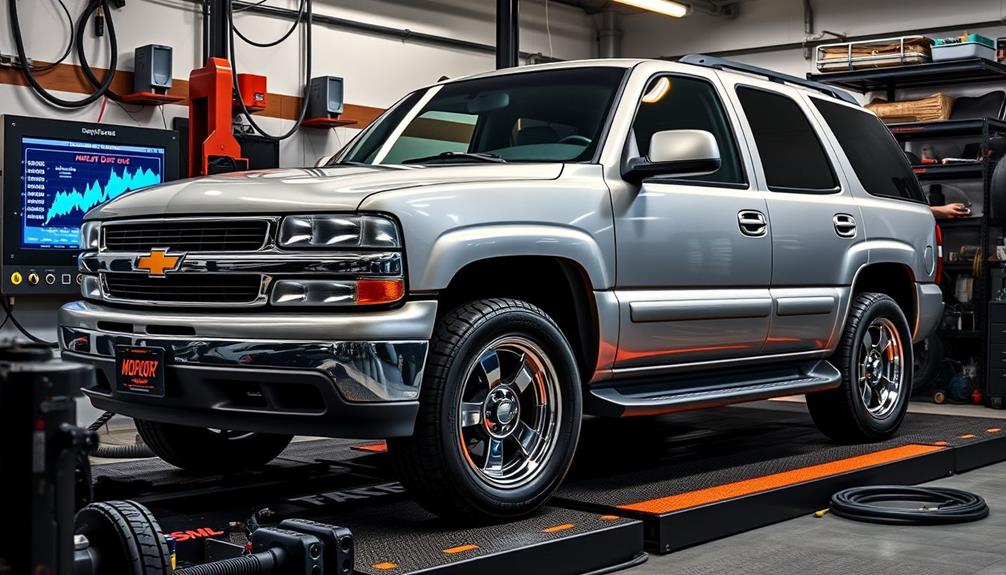
AutoCal tuning provides a tailored approach to enhancing the performance of your 2001 Chevrolet Tahoe. With custom-designed tunes specifically crafted for your vehicle's unique specifications and modifications, you can achieve optimized performance that suits your driving style.
The process involves using OEM tune files and scans of your vehicle's operating conditions, guaranteeing accurate customization that can lead to impressive performance gains of 15-30 hp and 15-25 ft-lbs of torque.
One of the standout features of AutoCal tuning is its compatibility with GM vehicles from 1998 to 2018, allowing you to manage up to 600 vehicles on a single device. If you're comfortable with Windows PCs or laptops (Win7 or higher), you'll find AutoCal's user-friendly interface makes installation and tuning adjustments straightforward.
Beyond just raw power, AutoCal tuning offers enhancements in shift patterns, towing capabilities, and fuel economy.
Scan Cable Tune Process

The Scan Cable Tune process offers a seamless way to achieve custom tuning for your 2001 Chevrolet Tahoe, building on the benefits of AutoCal tuning. To begin, you'll need to make a deposit of $400 for the scan cable, which you'll get back once you return it after the tuning process.
You'll be required to provide detailed vehicle data logs following specific instructions, enabling accurate analysis and adjustments to your tune. After the analysis, tuned computer files are mailed back to you for installation, and a follow-up log is necessary to guarantee the adjustments are effective. This entire process facilitates custom tuning of your vehicle's performance based on real-time data, enhancing power and drivability.
Here's a quick overview of the process:
| Step | Action Required | Notes |
|---|---|---|
| 1. Deposit | Pay $400 for scan cable | Refundable upon return |
| 2. Data Collection | Provide detailed vehicle data | Follow specific instructions |
| 3. Installation | Install returned computer files | Submit follow-up log for effectiveness |
Traditional Tune Advantages
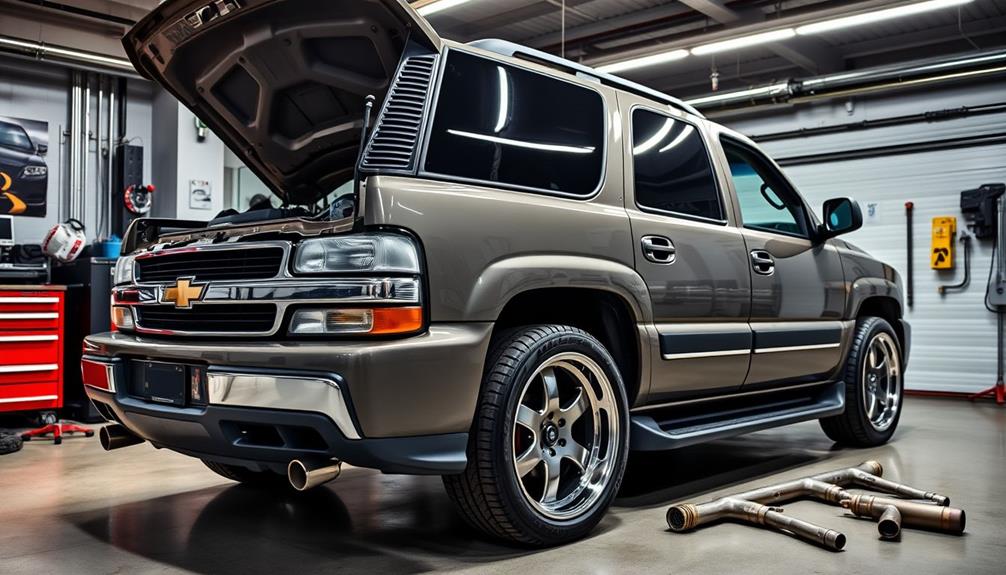
When you opt for a traditional tune for your 2001 Chevrolet Tahoe, you'll enjoy a simplified tuning process that doesn't require complex setups.
This method has a proven track record of delivering performance gains, typically adding 15-30 horsepower and 15-25 ft-lbs of torque.
Plus, it's a cost-effective solution for boosting your SUV's driveability while meeting your practical needs.
Simplified Tuning Process
For many owners of the 2001 Chevrolet Tahoe, choosing a traditional tune simplifies the tuning process while delivering impressive performance gains. This custom mail-order tune leverages the experiences of tuning providers with similar vehicles, ensuring that you get enhancements without the hassle of data-logging.
Here's what makes the traditional tune a smart choice:
- Increased Horsepower and Torque: You'll notice a boost in power, improving your Tahoe's overall driveability for daily driving scenarios.
- Easy Communication: You can easily contact tuning providers to get estimated performance gains tailored to your specific vehicle and modifications.
- Compatibility with Modifications: The traditional tune accommodates a variety of upgrades, ensuring that your enhancements work seamlessly with your Tahoe's existing setup.
This simplified tuning process stands out as an attractive option for those looking to boost power without the complexity.
With minimal hassle and a focus on tailored performance gains, it's easy to see why many Tahoe owners lean toward a traditional tune for their performance needs.
Proven Performance Gains
Many 2001 Chevrolet Tahoe owners experience notable performance boosts after opting for a traditional tune, with gains typically ranging from 15 to 30 horsepower and 15 to 25 ft-lbs of torque.
This tuning approach stands out because it simplifies the process; you won't need to fuss with data-logging or extensive modifications to your vehicle. Additionally, enhancing your vehicle's performance can be likened to selecting the best vacuums for dust removal in 2024, where choosing the right option makes a significant impact.
The traditional tune is built from past experiences with similar vehicles, ensuring that the enhancements are tailored for improved driveability. You can expect significant performance improvements in your daily driving experience, making your Tahoe feel more responsive and enjoyable on the road.
Whether you're merging onto the highway or maneuvering city streets, you'll notice that your SUV performs better.
Additionally, traditional tunes are particularly advantageous for those seeking a straightforward upgrade path. There's no need for complex installations or additional equipment, which means you can get back on the road quickly after tuning.
Cost-Effective Solution
Opting for a traditional tune not only enhances your 2001 Chevrolet Tahoe's performance but also proves to be a cost-effective solution for drivers looking to maximize their investment.
This type of tuning simplifies the process, providing a custom mail-order solution without the need for data-logging. You'll enjoy reliable performance gains built from past experiences with similar vehicles, ensuring you get the most out of your SUV.
Here are three key advantages of a traditional tune:
1) Performance Gains: You can expect an increase of 15 to 30 hp and 15 to 25 ft-lbs of torque, greatly boosting your Tahoe's capabilities.
2) Improved Driveability: Better throttle response and handling make your driving experience more enjoyable.
3) Budget-Friendly: The cost of a traditional tune is generally lower than other tuning methods, making it easier on your wallet.
Additional Performance Services

Enhancing your 2001 Chevrolet Tahoe's performance goes beyond standard tuning; it involves a range of additional services that can greatly boost your driving experience.
With performance tuning, you can expect an increase in horsepower by 15-30 hp and torque by 15-25 ft-lbs, which markedly improves overall performance.
You'll also benefit from improved shift patterns, enhanced towing capabilities, and better fuel economy, making your Tahoe more efficient for daily driving.
Options like AutoCal allow for multiple vehicle licensing, supporting up to 600 vehicles, while traditional mail-order tunes simplify the process without requiring data-logging.
Moreover, these services accommodate various modifications, including internal engine upgrades, superchargers, turbochargers, and upgraded transmissions, ensuring your performance enhancements are tailored to your needs.
Beyond tuning, consider additional services like speed and rev limiter increases, torque management changes, and tire/gear change calibration to further optimize your vehicle's performance.
Current Modifications for Tahoe
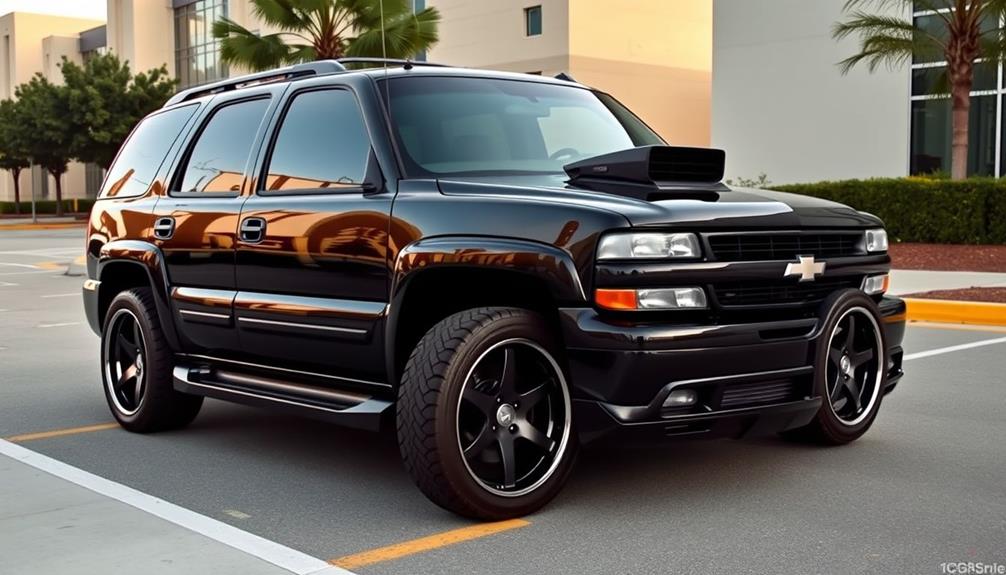
With a focus on practicality and performance, the current modifications for the 2001 Chevrolet Tahoe include a K&N cold air intake that boosts airflow and engine efficiency.
These enhancements aim to strike a balance between increased horsepower and improved drivability, making your daily driving experience more enjoyable.
Here's a quick rundown of the current modifications:
- K&N Cold Air Intake: This system optimizes airflow, leading to better throttle response and fuel efficiency. You'll notice a more robust engine performance right away.
- Borla Dual Cat-Back Exhaust: This upgrade enhances exhaust flow while delivering a more aggressive sound. It not only improves power but also gives your Tahoe a sporty character that stands out on the road.
- Straightforward Modifications: The focus has been on bolt-on upgrades without any planned engine disassemblies.
This approach keeps things accessible and hassle-free, allowing you to enjoy your Tahoe's performance without extensive downtime.
Suggested Bolt-On Upgrades
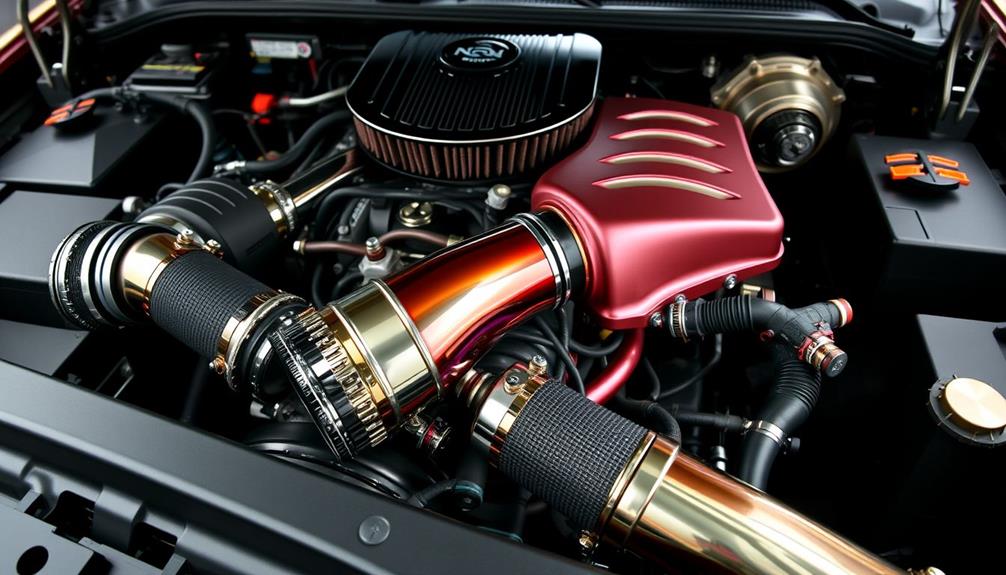
If you're looking to amp up your 2001 Chevrolet Tahoe, consider some bolt-on upgrades that can really make a difference.
High-performance power programmers and upgraded airflow components can optimize your engine's efficiency, while exhaust system enhancements can boost your horsepower.
These modifications not only improve performance but also enhance your driving experience overall.
High-Performance Power Programmers
High-performance power programmers are often the go-to choice for those looking to release more power from their 2001 Chevrolet Tahoe.
These devices, such as the Superchips FlashPaq and DiabloSport inTune i3 Platinum, can boost horsepower and torque by 15 to 30 hp and 15 to 25 ft-lbs, respectively. By modifying factory settings, these tuners optimize ignition timing, fuel pressure, and air/fuel mixture, enhancing your Tahoe's overall engine efficiency and drivability.
Here are three key benefits of using a power programmer:
- Ease of Use: Programmers like the HPP3 are user-friendly, making them perfect for everyday drivers who want performance upgrades without complex modifications.
- Custom Tuning: For tailored performance, consider custom PCM tuning from vendors like pcmforless.com, which fine-tunes adjustments based on your specific engine setup.
- Cost-Effective Gains: With prices ranging from $272.21 to $643.46, performance programmers offer significant improvements while retaining daily driving comfort.
Investing in a high-performance power programmer is a simple yet effective way to elevate your Tahoe's capabilities.
Upgraded Airflow Components
To maximize your 2001 Chevrolet Tahoe's performance, consider investing in upgraded airflow components that enhance both air intake and exhaust efficiency.
Start with a high-performance mass air flow sensor. This upgrade can greatly boost air intake efficiency, leading to improved overall engine performance.
Next, think about a quality cold air intake system, like the Banks Ram-Air™ system. It can outflow the stock intake by 29%, providing better power and fuel economy.
Pair this with an aftermarket throttle body to further increase airflow, complementing the other upgrades.
You might also consider installing long tube headers, which optimize exhaust flow and can add around 25 horsepower to your full-size SUV.
For the best results, combine these modifications with a performance programmer specifically designed for your 5.3L engine. This combination can yield substantial improvements in horsepower and torque, maximizing the benefits of your upgraded airflow components.
Exhaust System Enhancements
Upgrading your 2001 Chevrolet Tahoe's exhaust system can lead to considerable performance gains and a more aggressive sound. By enhancing the exhaust flow, you'll notice improvements in horsepower and torque, making your full-size SUV even more powerful.
Here are three suggested bolt-on upgrades to take into account:
- Dual Cat-Back Borla Exhaust System: This upgrade greatly enhances exhaust flow, directly contributing to improved horsepower and torque. You'll love the aggressive sound it adds to your ride.
- Long Tube Headers: Installing long tube headers maximizes exhaust gas evacuation, potentially adding an extra 10-20 horsepower, depending on your other modifications. This change can be a game-changer for your Tahoe.
- High-Flow Muffler: A high-flow muffler refines the exhaust sound while boosting performance metrics. It's a simple yet effective upgrade that helps reduce back pressure, enhancing power output and fuel efficiency.
For ideal results, think about combining these exhaust enhancements with a performance tuner. This synergy maximizes gains in horsepower and torque, offering you a more responsive driving experience.
Don't wait—transform your Tahoe's performance today!
Performance Programmer Options

If you're looking to boost your 2001 Chevrolet Tahoe's performance, exploring performance programmer options is a smart move. These devices modify your vehicle's factory tune, enhancing performance by adjusting ignition timing, fuel pressure, and air/fuel mixture. As a result, you can expect noticeable increases in horsepower and torque.
Here's a quick comparison of some popular performance programmers:
| Programmer | Price Range |
|---|---|
| Superchips FlashPaq | $272.21 – $399.99 |
| Edge CTS3 Evolution | $399.99 – $599.99 |
| DiabloSport inTune i3 Platinum | $643.46 |
| DiabloSport Trinity 2 Platinum | $499.99 |
Handheld flash programmers are especially advantageous for the 2001 Tahoe. They offer easy plug-and-play installation while delivering dyno-proven performance gains. The DiabloSport Trinity 2 Platinum, for example, stands out with its advanced features and user-friendly interface, making it a favorite among enthusiasts. With the right tuning adjustments, not only can these programmers enhance power, but they can also improve fuel efficiency, making them a practical choice for daily driving without sacrificing performance.
Supercharger Installation Insights

When you consider installing a supercharger on your 2001 Chevrolet Tahoe, you're looking at impressive horsepower gains and improved acceleration.
It's crucial to assess your current modifications to guarantee everything works seamlessly together.
Plus, keeping up with maintenance will help you enjoy that enhanced performance for years to come.
Supercharger Benefits Overview
Adding a supercharger to your Chevrolet Tahoe can greatly elevate its performance, providing considerable horsepower gains that often exceed 50 hp. This modification isn't just about raw power; it's a cost-effective solution that delivers greater performance improvements than multiple bolt-on upgrades combined.
Here are some key benefits of adding a supercharger:
- Improved Acceleration: A well-matched supercharger can remarkably enhance your quarter-mile times by over 10 mph, making your Tahoe feel more responsive on the road.
- Minimal Maintenance: Compared to other modifications, superchargers require relatively little upkeep. Regular checks on fuel filters and transmission fluid are usually sufficient to keep everything running smoothly.
- Enhanced Power Delivery: Installing a shift kit is recommended to improve transmission handling when you add a supercharger, ensuring that the additional power is effectively transmitted to the wheels.
With these advantages, a supercharger upgrade can transform your Tahoe into a performance powerhouse, giving you the thrill of driving without the extensive maintenance worries of other options.
Embrace the boost and release your SUV's full potential!
Installation Considerations
After considering the benefits a supercharger brings to your 2001 Chevrolet Tahoe, it's important to focus on the installation process to guarantee everything runs smoothly.
First, make sure the supercharger you choose is compatible with any existing modifications, like cold air intakes and exhaust systems. This compatibility maximizes your performance gains.
Next, consider installing a shift kit alongside the supercharger. This upgrade enhances your transmission's handling and responsiveness as it deals with the increased power load. You could see significant horsepower increases, often exceeding 75 hp, making it a cost-effective solution compared to other modifications.
Before diving into the installation, check your local emissions standards. Ensuring your supercharger system complies with these regulations is vital for legality and vehicle registration. You don't want any surprises down the road!
Lastly, while the focus is on the supercharger, don't forget about regular maintenance checks on your fuel filters and transmission fluid. Keeping these components in top shape is essential for the supercharger's peak functioning and helps avoid potential issues.
With these considerations in mind, you're set for a smooth installation process.
Maintenance Requirements
Maintaining your supercharger is crucial for guaranteeing your 2001 Chevrolet Tahoe runs at its best. To keep your supercharged system performing at peak efficiency, follow these key maintenance requirements:
- Regular Inspections: Check the fuel filters and transmission fluid frequently. These components are essential for your SUV's performance, especially after installing a supercharger.
- Monitor Engine Parameters: Keep an eye on engine temperatures and boost levels. This helps prevent overheating and guarantees your system operates reliably under increased power outputs.
- Supercharger Component Care: Routinely inspect the supercharger itself, including the belt and bearings. Addressing wear and tear early can save you from potential failures and maintain consistent performance.
Additionally, consider installing a shift kit alongside your supercharger. This improves transmission handling when your Tahoe experiences increased power.
Remember, the cost-effectiveness of supercharging is notable, as it typically provides significant horsepower gains compared to multiple smaller modifications.
Performance Expectations and Gains
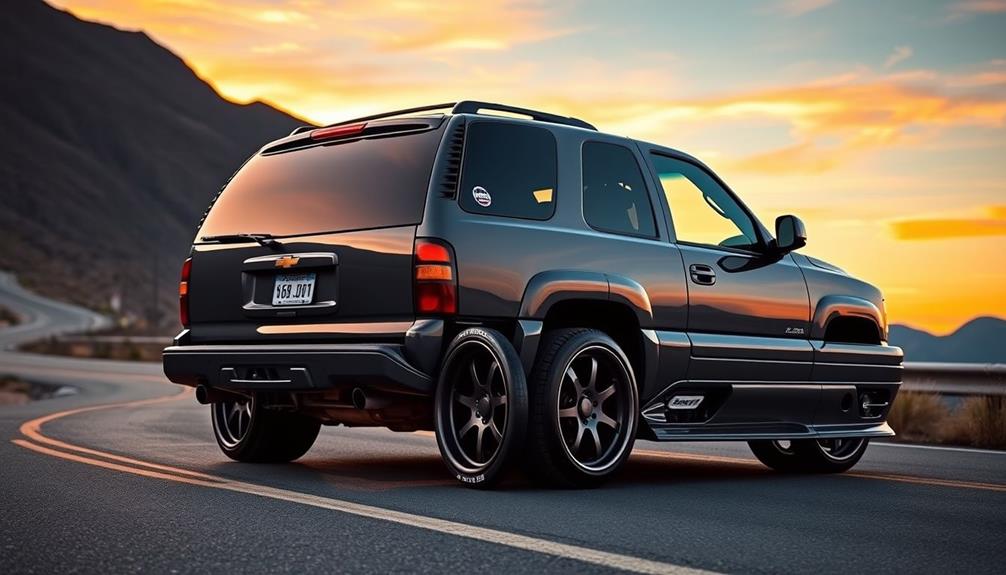
When you plunge into tuning your 2001 Chevrolet Tahoe, you can expect impressive performance gains from various modifications. With bolt-on upgrades, you can easily add around 25 horsepower, giving your SUV a noticeable boost in performance. If you're looking for more dramatic changes, consider installing a supercharger; it can considerably increase horsepower and improve your quarter-mile times by over 10 mph.
Performance tuning also plays a key role, typically providing gains of 15-30 hp and 15-25 ft-lbs of torque. This not only enhances acceleration but also improves drivability. By utilizing performance programmers, you can adjust the factory tune to optimize ignition timing and fuel delivery, further increasing efficiency and power output.
Keep in mind that real-world performance expectations can vary based on the specific modifications and tuning adjustments you make. Here's a quick look at potential gains:
| Modification Type | Expected Gains |
|---|---|
| Bolt-on Modifications | ~25 hp |
| Supercharger | 10+ mph quarter-mile |
| Performance Tuning | 15-30 hp, 15-25 ft-lbs |
| Performance Programmers | Optimized efficiency |
Emphasizing thorough upgrades will guarantee you achieve maximum gains.
Frequently Asked Questions
How Much Horsepower Does a 2001 Chevy Tahoe 5.3 Have?
A 2001 Chevy Tahoe with a 5.3L V8 engine produces about 285 horsepower. If you're looking to enhance performance, consider tuning options and modifications that can increase your power output considerably.
How to Increase Mpg Chevy Tahoe?
To increase your Chevy Tahoe's mpg, focus on maintaining proper tire pressure, scheduling regular oil changes, and adopting smooth driving habits. Consider upgrading the air intake system and using a performance programmer for better efficiency.
Can You Put a Turbo in a Chevy Tahoe?
Absolutely, you can turbocharge your Chevy Tahoe, transforming it into a beast of power! Just make sure you upgrade essential components and tune the engine properly to release its full potential without risking damage.
What Is the Fastest Tahoe?
The fastest Tahoe you can find is the 2021 Chevy Tahoe RST, boasting a powerful 6.2L V8 engine. It rockets from 0 to 60 mph in just 5.8 seconds, delivering an exhilarating driving experience.
Conclusion
By tuning your 2001 Chevrolet Tahoe, you're not just enhancing performance; you're transforming your driving experience. Imagine feeling the thrill of increased power and responsiveness every time you hit the gas. With the right upgrades and tuning services, your full-size SUV can deliver impressive gains that make every journey more enjoyable. Why settle for stock performance when you can release the beast within? Give your Tahoe the boost it deserves and enjoy the ride of your life! With new tuning options for Silverado 2021, there are even more ways to elevate the performance of your Tahoe. Whether it’s improved fuel efficiency, increased torque, or a more aggressive exhaust note, these tuning options can take your driving experience to the next level. Don’t miss out on the opportunity to unleash the full potential of your Chevrolet Tahoe with the latest tuning technology available for the Silverado 2021.
